Spatio-Temporal Analysis of Beijing Residents’ Lifestyles: Data-Driven Insights into Apartment Interior Design
Abstract
1. Introduction
2. Materials and Methods
2.1. Ethnographic User Observation
2.2. Noldus Observer XT
2.3. Sample Selection
2.4. Setting Code Schema
2.5. Observation Process
3. Results
3.1. Living Behavior Dataset
- The Excel file contains information about the behavior of the users in the observation, as well as the space and the objects used.
- The “Case Code” column shows the households’ coding and the recording date, with a total of six household codes: ab2.01; c3.04; a2.02; c2.02; b2.01; and c3.02. Each household contains 14 days of data in the format xx months xx day.
- The “Time” column indicates when the behavior occurred in the hour: minute: second format in 24 h format.
- The “Duration” column records the duration of the behavior; the duration is only present in the code of the start of the behavior, and the data are blank in the stop code.
- The “User” column records the emitter of the behavior.
- The “Behavior” column indicates the specific behavior performed, which is divided into 41 types and grouped into 11 main behavior categories (specific codes are detailed in Table 6).
- The “Space” column indicates where the behavior occurred.
- The “Start–Stop” column expresses the start attribute of the behavior, divided into start and stop.
- The “Insight” column records the researcher’s perception of the behavior during observation.
3.2. Behavior Duration and Frequency Data
3.3. User Behavior Timeline Data
4. Discussion
4.1. General Analysis of Lifestyles
4.2. The Design Direction of the Interior Through Lifestyles
- Design that considers temporal differences in behavior.
- 2.
- Living room design centered on child behavior.
- 3.
- Common family behavior linked to eating behavior.
- 4.
- The consideration of the home office and the massive use of electronic devices in the digital age.
5. Conclusions
Author Contributions
Funding
Institutional Review Board Statement
Informed Consent Statement
Data Availability Statement
Acknowledgments
Conflicts of Interest
References
- Jin, C.; Chen, Z. Housing Inclusion Perspective: The Causal Structure of Housing Cost Burden, Fertility Intentions, and Social Housing in Urban China. Sustainability 2024, 16, 9352. [Google Scholar] [CrossRef]
- Andargie, M.S.; Touchie, M.; O’Brien, W. A review of factors affecting occupant comfort in multi-unit residential buildings. Build. Environ. 2019, 160, 106182. [Google Scholar] [CrossRef]
- Ellsworth-Krebs, K.; Reid, L.; Hunter, C.J. Integrated framework of home comfort: Relaxation, companionship and control. Build. Res. Inf. 2019, 47, 202–218. [Google Scholar] [CrossRef]
- Mitton, M.; Nystuen, C. Residential Interior Design: A Guide to Planning Spaces; John Wiley & Sons: Hoboken, NJ, USA, 2021. [Google Scholar]
- Yang, H.; Lee, W.; Lee, H. IoT smart home adoption: The importance of proper level automation. J. Sens. 2018, 2018, 6464036. [Google Scholar] [CrossRef]
- Heydarian, A.; Pantazis, E.; Wang, A.; Gerber, D.; Becerik-Gerber, B. Towards user-centered building design: Identifying end-user lighting preferences via immersive virtual environments. Autom. Constr. 2017, 81, 56–66. [Google Scholar] [CrossRef]
- Choi, W. Design Approach to Support Prospective Memory for Independent Living among Aging People. Arch. Des. Res. 2016, 29, 79–96. [Google Scholar] [CrossRef]
- Liu, J.; Liu, T.X. Two-child policy, gender income and fertility choice in China. Int. Rev. Econ. Financ. 2020, 69, 1071–1081. [Google Scholar] [CrossRef]
- Xu, X.; Hanafi, Z.; Razak, N.A. Exploring Sociodemographic Correlates of Fathers’ and Mothers’ Behavioral Control. Behav. Sci. 2024, 14, 1203. [Google Scholar] [CrossRef] [PubMed]
- Ytrehus, S. Interpretation of housing needs? A critical discussion. Hous. Theory Soc. 2000, 17, 166–174. [Google Scholar] [CrossRef]
- Choi, K.R.; Choi, J.M.; Sato, K. Socio-Cultural Factors for New Product Acceptance in Home Environment Design. J. Hum.-Environ. Syst. 2008, 11, 65–71. [Google Scholar] [CrossRef][Green Version]
- Rapoport, A. Theory, culture and housing. Hous. Theory Soc. 2000, 17, 145–165. [Google Scholar] [CrossRef]
- Ettema, D.; van der Lippe, T. Weekly rhythms in task and time allocation of households. Transportation 2009, 36, 113–129. [Google Scholar] [CrossRef][Green Version]
- Gao, C.; Wang, Y. Study on the Coupling Association between Human and House under the Influence of the Evaluation Index of Urban Residents’ Behavior. J. Phys. Conf. Ser. 2021, 1838, 012056. [Google Scholar] [CrossRef]
- Ganvir, L.; Kalita, C.P. Adoption of Socio-Cultural Aspects in PSS Design for Smart Home Products: An Integrative Review. Arch. Des. Res. 2022, 35, 7–29. [Google Scholar] [CrossRef]
- Kuo, T.C.; Wu, H.H.; Shieh, J.I. Integration of environmental considerations in quality function deployment by using fuzzy logic. Expert Syst. Appl. 2009, 36, 7148–7156. [Google Scholar] [CrossRef]
- Kim, H.J.; Choi, K.R.; Sung, Y.J. Multi-Functional Furniture Design in Small Living Space. J. Korea Furnit. Soc. 2011, 22, 190–198. [Google Scholar]
- Pea, R.D. User centered system design: New perspectives on human-computer interaction. J. Educ. Comput. Res. 1987, 3, 129–134. [Google Scholar]
- Daae, J.; Boks, C. A classification of user research methods for design for sustainable behaviour. J. Clean. Prod. 2015, 106, 680–689. [Google Scholar] [CrossRef]
- Rosted, J. User-Driven Innovation. Results and Recommendations; Fora: Copenhagen, Denmark, 2005. [Google Scholar]
- Won, H. Designs for sensing radiation: Deployment of a tangible interface and a visual projection interface for user interaction. Arch. Des. Res. 2020, 33, 57–71. [Google Scholar] [CrossRef]
- Tsukada, A.; Maeda, T.; Yanagisawa, H.; Kaneko, S.; Mirakami, T.; Tozaki, M.; Tamaru, E.; Hasuike, K. Proposal for User-observation Design Assistant System Focused on Field Work. IFAC Proc. Vol. 2010, 43, 245–250. [Google Scholar] [CrossRef]
- Jaglarz, A. Color as a Key Factor in Creating Sustainable Living Spaces for Seniors. Sustainability 2024, 16, 10251. [Google Scholar] [CrossRef]
- Zhou, M.; Li, M.; Ono, K.; Watanabe, M. A Comparative Study of the User Interaction Behavior and Experience in a Home-Oriented Multi-User Interface (MUI) During Family Collaborative Cooking. Future Internet 2024, 16, 478. [Google Scholar] [CrossRef]
- Nippert-Eng, C. Watching Closely: A Guide to Ethnographic Observation; Oxford University Press: Oxford, UK, 2015. [Google Scholar]
- Lee, R.P. A Study on the early modernist woman architect, Margarete Schutte-Lihotzky-A Revolution of woman’s space or an assignment to the new industrialization? Korean Inst. Inter. Des. J. 2005, 14, 20–27. [Google Scholar]
- Yanagisawa, H.; Kozuka, Y.; Matsunaga, M.; Murakami, T. Observation support system for recording, reviewing and sharing observed design problems. In Proceedings of the International Association of Societies of Design Research (IASDR 2009), Seoul, Republic of Korea, 18–22 October 2009; pp. 1–10. [Google Scholar]
- Janesick, V.J. Ethnographic inquiry: Understanding culture and experience. In Forms of Curriculum Inquiry; State University of New York Press: New York, NY, USA, 1991; pp. 101–119. [Google Scholar]
- Lopez-Dicastillo, O.; Belintxon, M. The challenges of participant observations of cultural encounters within an ethnographic study. Procedia-Soc. Behav. Sci. 2014, 132, 522–526. [Google Scholar] [CrossRef]
- Martin, J.L.; Clark, D.J.; Morgan, S.P.; Crowe, J.A.; Murphy, E. A user-centred approach to requirements elicitation in medical device development: A case study from an industry perspective. Appl. Ergon. 2012, 43, 184–190. [Google Scholar] [CrossRef] [PubMed]
- Ducharme, D.A.; Arcand, I. Using Noldus Observer XT for research on deaf signers learning to read: An innovative methodology. Behav. Res. Methods 2009, 41, 833–840. [Google Scholar] [CrossRef] [PubMed]
- Cohen, I.L.; Gardner, J.M.; Karmel, B.Z.; Kim, S.Y. Rating scale measures are associated with Noldus EthoVision-XT video tracking of behaviors of children on the autism spectrum. Mol. Autism 2014, 5, 15. [Google Scholar] [CrossRef] [PubMed]
- Kanakri, S.M.; Shepley, M.; Tassinary, L.G.; Varni, J.W.; Fawaz, H.M. An observational study of classroom acoustical design and repetitive behaviors in children with autism. Environ. Behav. 2017, 49, 847–873. [Google Scholar] [CrossRef]
- Sun, R.; Zhang, G.; Yuan, Z. The Preliminary Application of Observer XT (12.0) in a Pilot-Behavior Study. In Proceedings of the Engineering Psychology and Cognitive Ergonomics: 15th International Conference, EPCE 2018, Held as Part of HCI International 2018, Las Vegas, NV, USA, 15–20 July 2018; Proceedings 15. Springer International Publishing: Berlin/Heidelberg, Germany, 2018; pp. 686–700. [Google Scholar]
- Noldus LP, J.J.; Spink, A.J.; Bollen, R.; Heffelaar, T. Smart mobility: Driver state estimation and advanced driver-vehicle interfaces. In Mobility Engineering, Proceedings of the CAETS 2015 Convocation on Pathways to Sustainability, New Delhi, India, 13–15 October 2015; Springer: Singapore, 2017; pp. 11–18. [Google Scholar]
- Huang, Y. The Analysis of User Research Method Based on User Cultural Factors-Focus on Behavior in Children’s Roomactors; Kookmin University: Seoul, Republic of Korea, 2008; Available online: http://www.riss.kr/link?id=T11475238 (accessed on 1 January 2022).
- Kim, M.; Choi, K.R. A Study on Kitchen Use Behaviors through User Observation-Focused on Small-sized Apartments in Shanghai, China. Korean Inst. Inter. Des. J. 2015, 24, 121–128. [Google Scholar]
- Liu, J.; Meng, B.; Wang, J.; Chen, S.; Tian, B.; Zhi, G. Exploring the Spatiotemporal Patterns of Residents’ Daily Activities Using Text-Based Social Media Data: A Case Study of Beijing, China. ISPRS Int. J. Geo-Inf. 2021, 10, 389. [Google Scholar] [CrossRef]
- Guan, C.Q.; Wang, Y.; Wang, Y. Grandparenting Role on Math Online Learning in Chinese Multigenerational Households. Sustainability 2022, 14, 11551. [Google Scholar] [CrossRef]
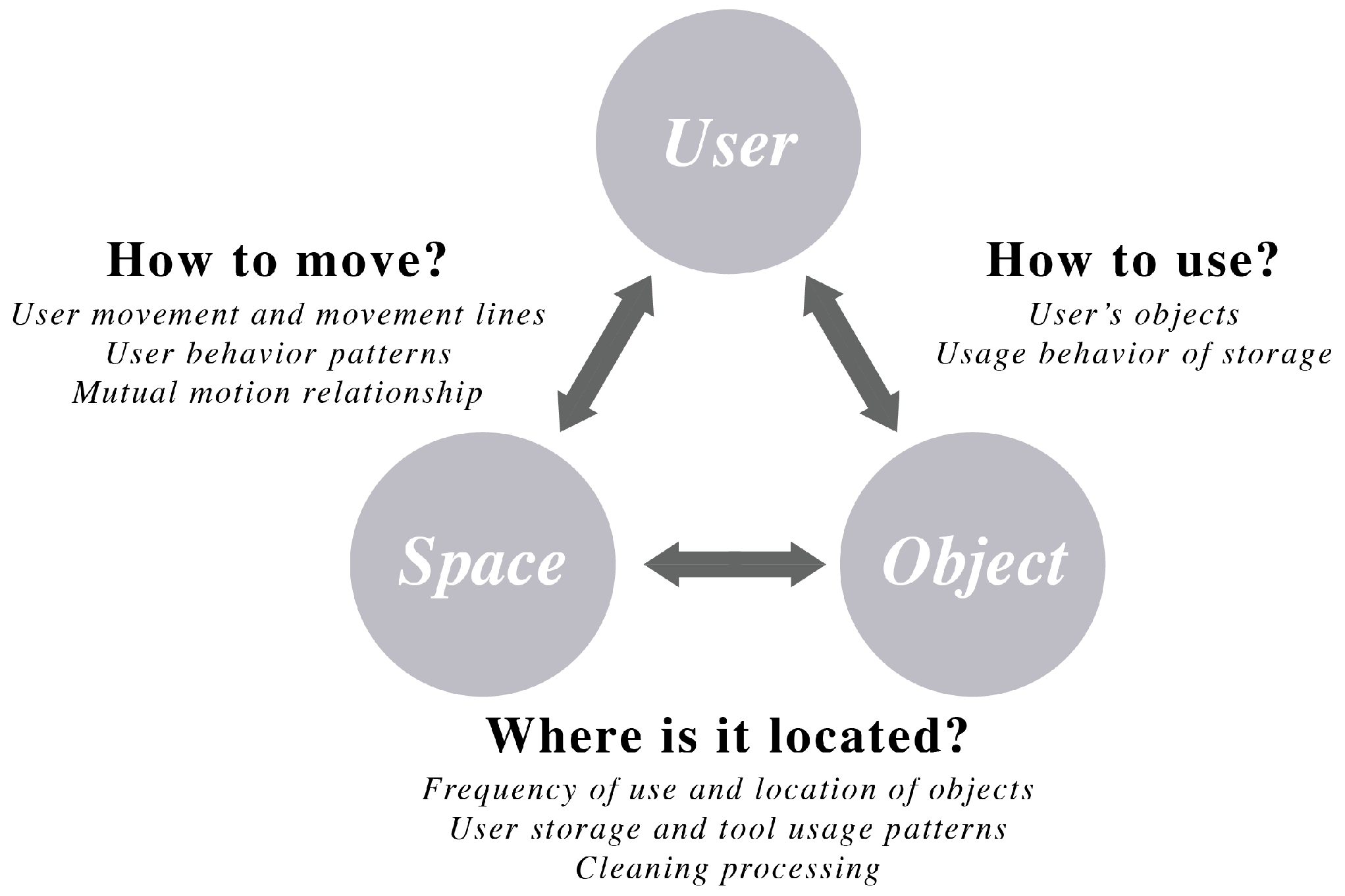



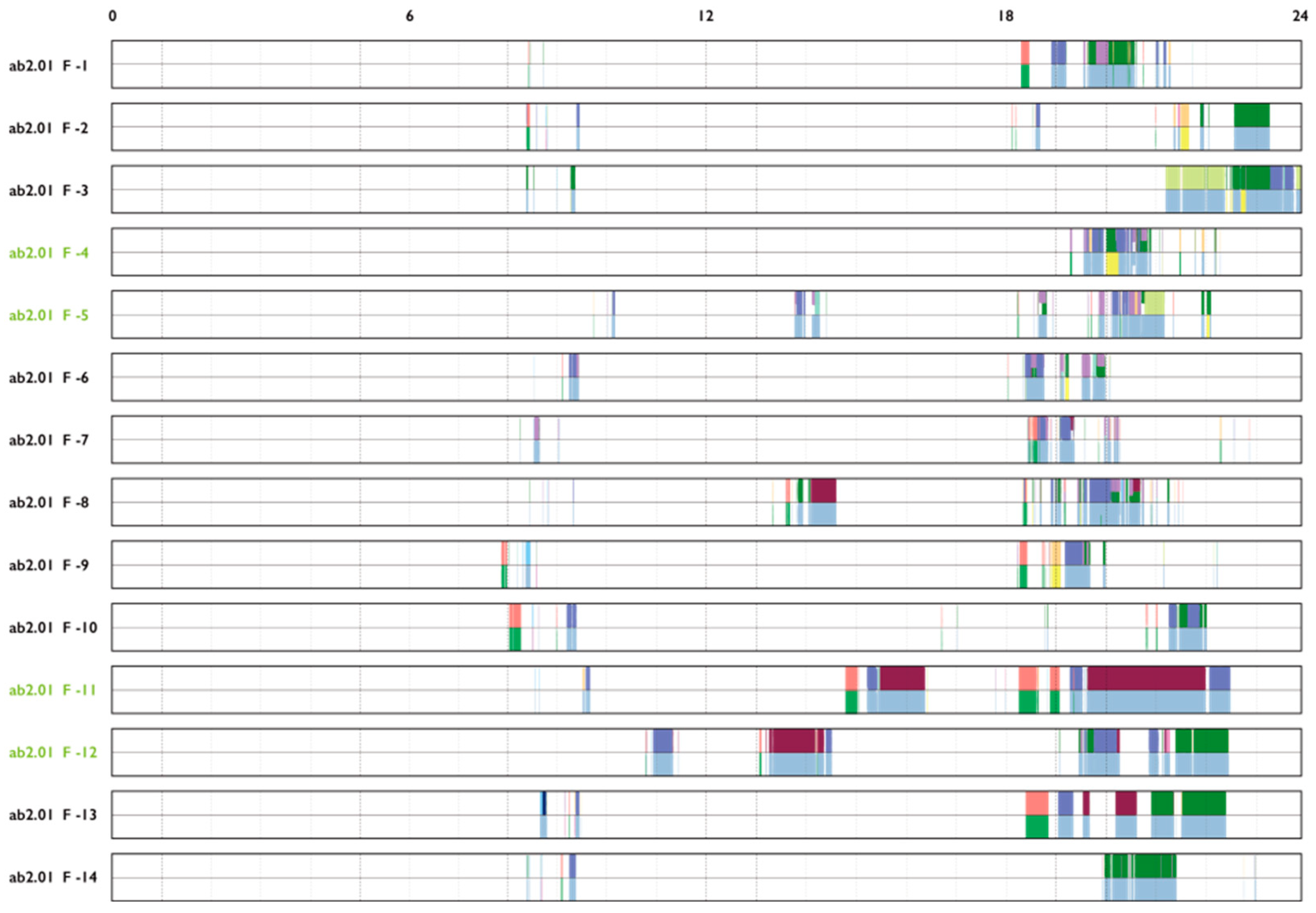

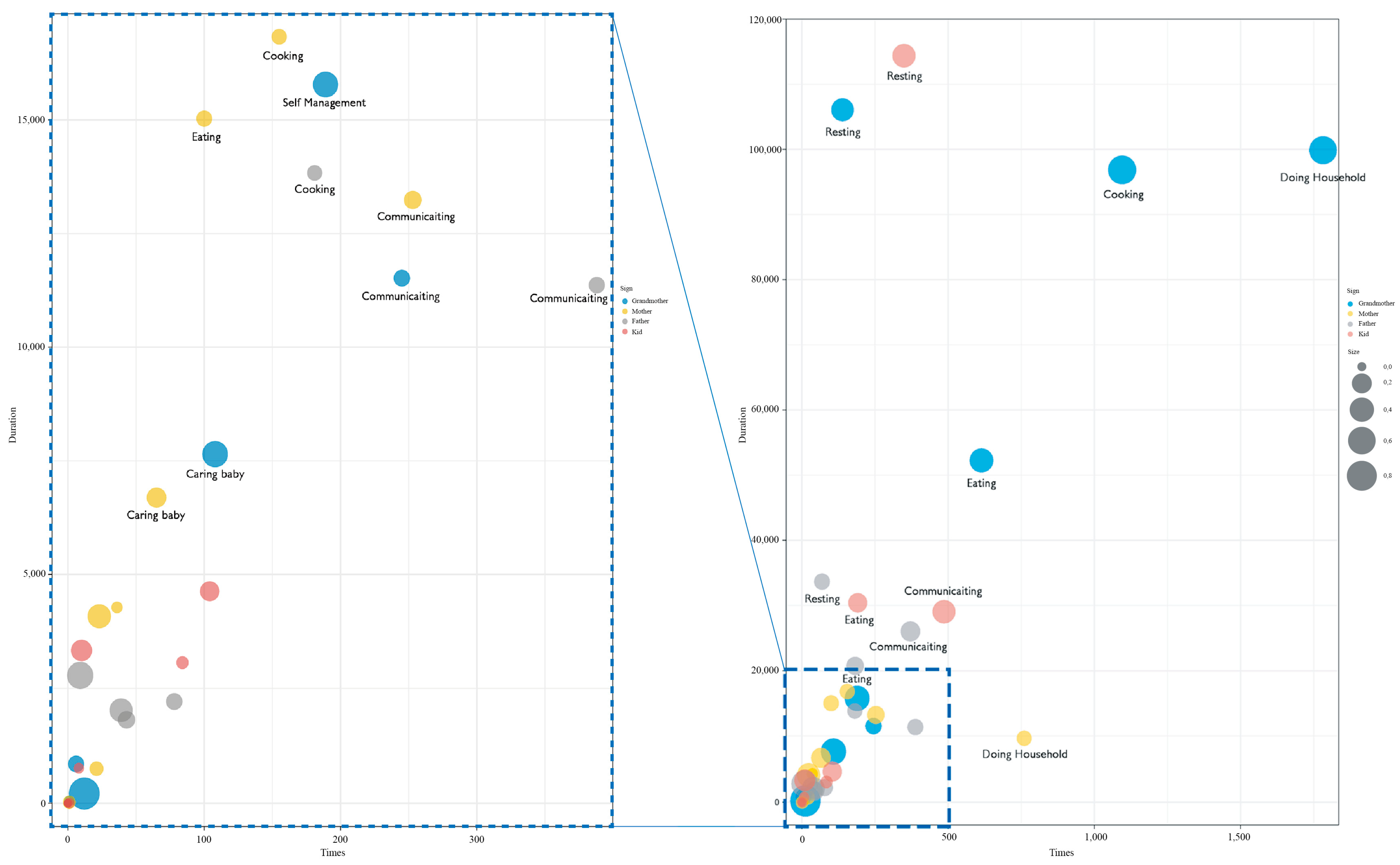
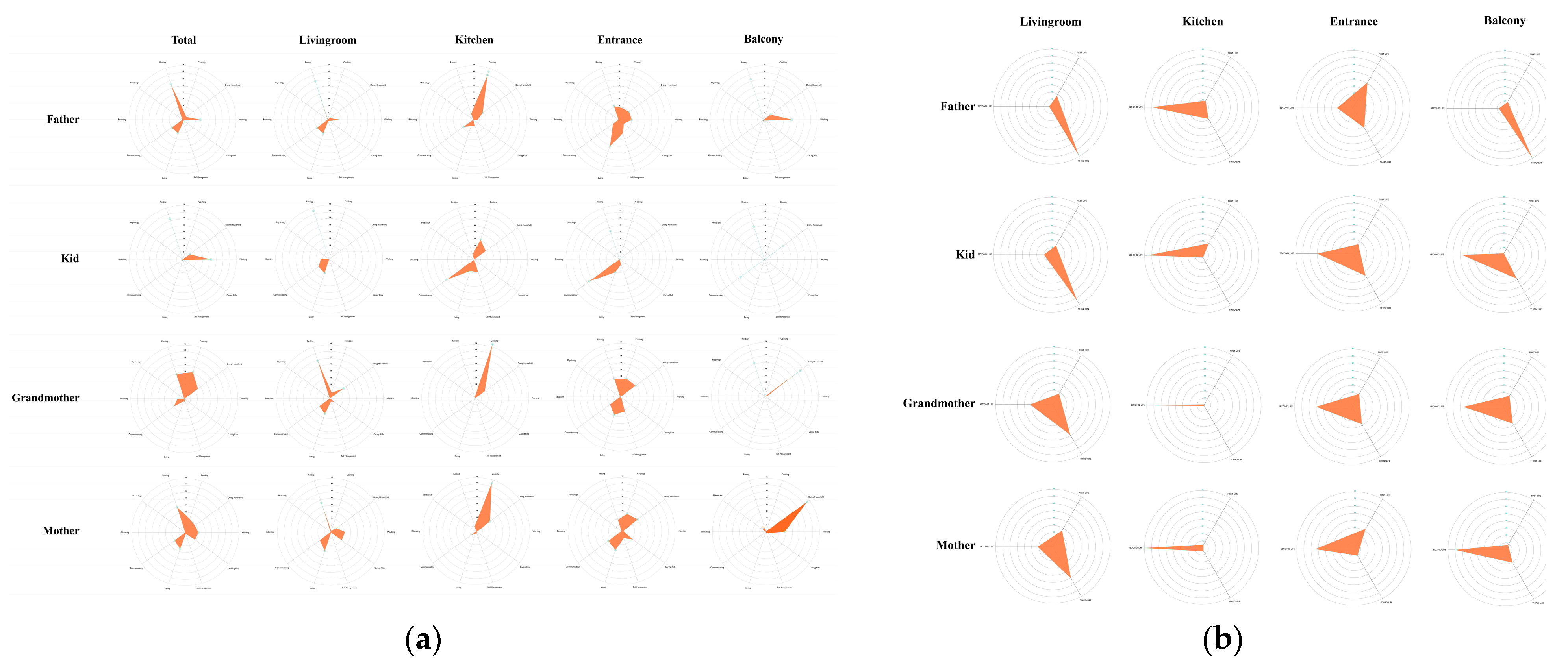
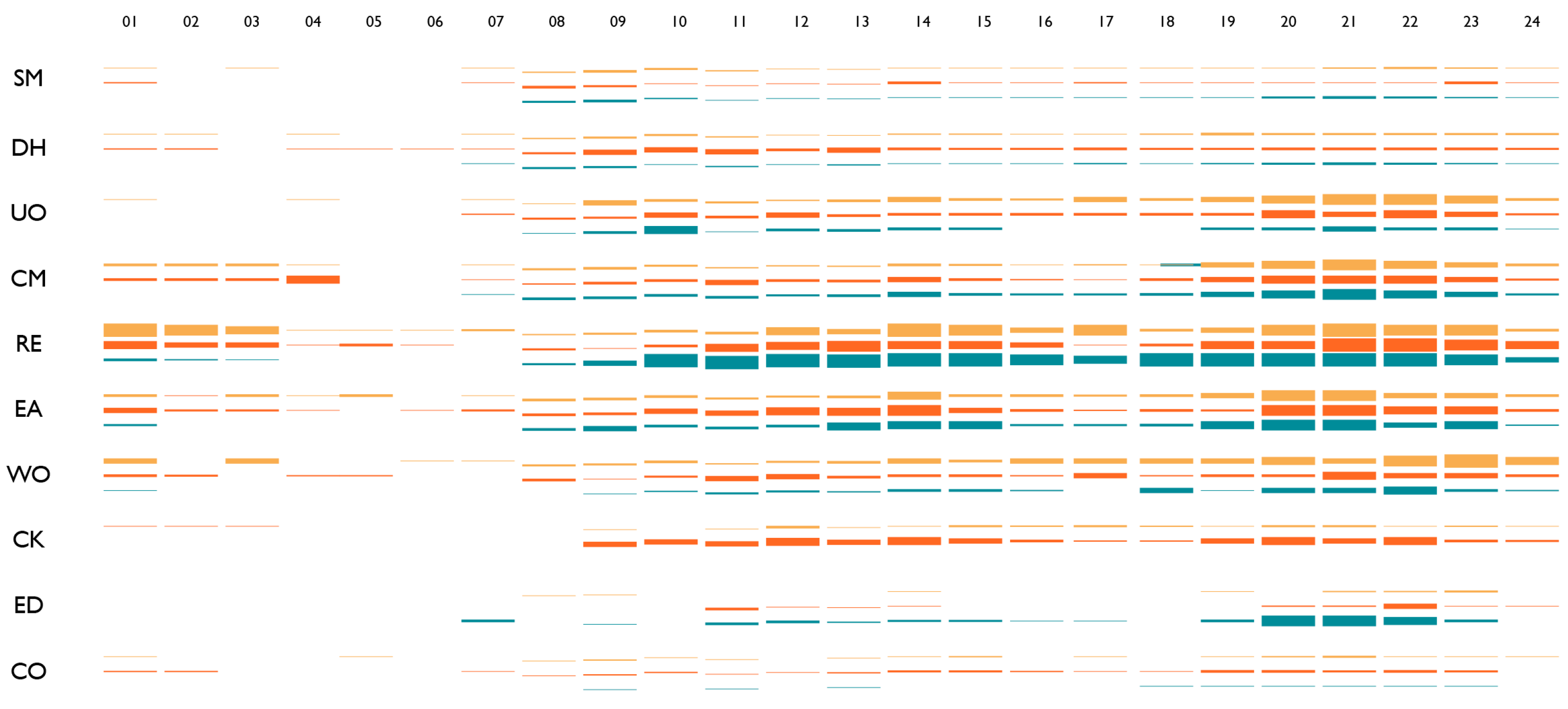
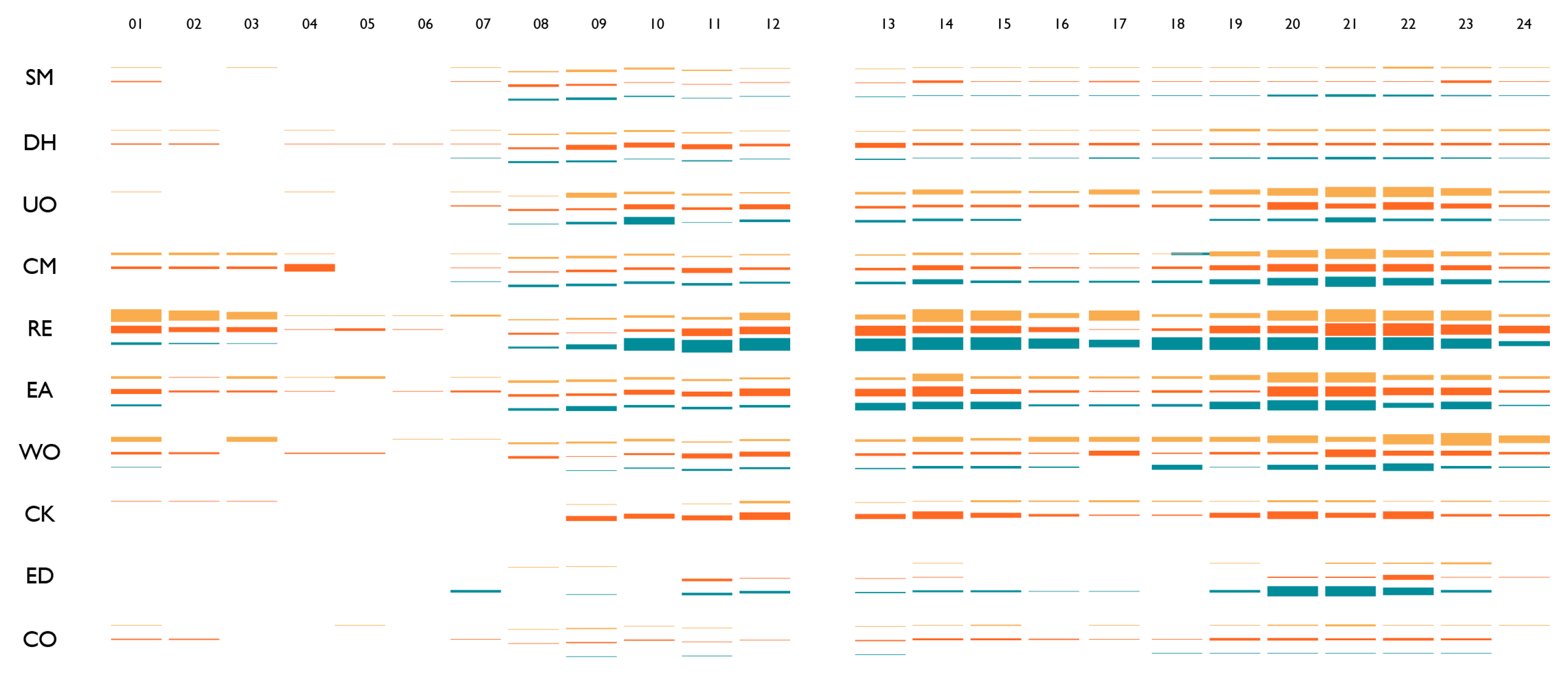
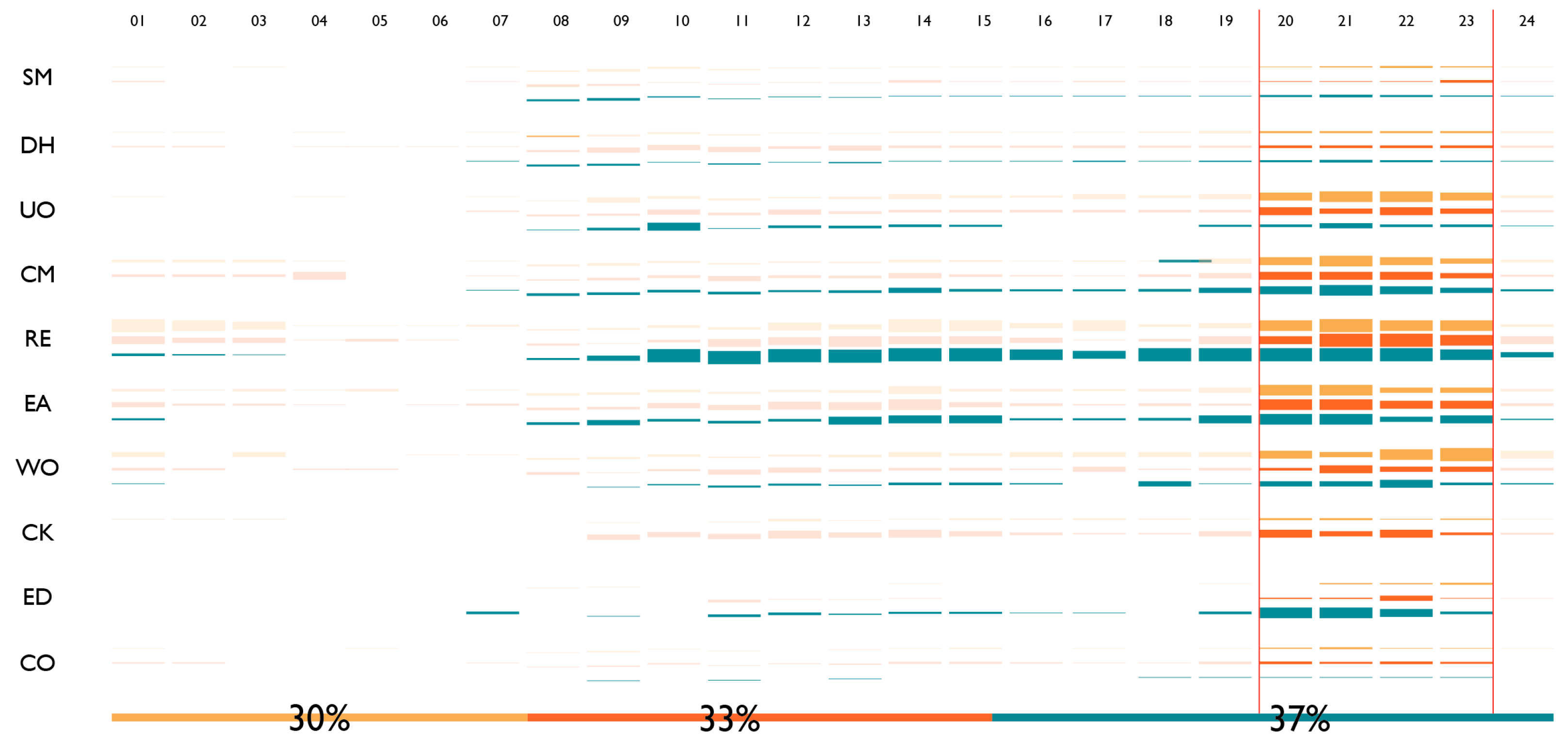

| Family Code | Plan | Information |
|---|---|---|
| a2.01 |  | 88 m2—Girl, 3rd |
| a2.02 |  | 89 m2—Boy, 3rd |
| a2.03 |  | 90 m2—Girl, 2nd |
| a2.04 |  | 100 m2—Boy, 3rd |
| a3.01 |  | 102 m2—Boy, 3rd |
| ac3.01 |  | 70 m2—Boy, 9th; Girl, 1st |
| ac3.02 |  | 110 m2—Boy, 10th; Girl, 1st |
| Family Code | Plan | Information |
|---|---|---|
| ab2.01 |  | 80 m2—Boy, 6th; Boy, 3m |
| ab3.01 |  | 150 m2—Boy, 7th; Boy, 7m |
| b3.01 |  | 141 m2—Boy, 7th |
| b2.01 |  | 89 m2—Girl, 5th |
| b2.02 |  | 141 m2—Boy, 7th |
| Family Code | Plan | Information |
|---|---|---|
| c3.01 |  | 138 m2—Girl, 9th |
| c3.02 |  | 143 m2—Boy, 9th |
| c3.03 |  | 80 m2—Girl, 8th |
| c3.04 |  | 76 m2—Boy, 7th |
| c2.01 |  | 120 m2—Girl, 10th |
| c2.02 |  | 89 m2—Boy, 8th |
| c2.03 |  | 65 m2—Boy, 10th |
| Family Code | Plan | Information |
|---|---|---|
| d2.01 |  | 94 m2—Boy, 13th |
| d2.02 |  | 70 m2—Boy, 13th |
| d2.03 |  | 99 m2—Boy, 16th |
| d2.04 |  | 150 m2—Boy, 13th |
| d3.01 |  | 135.5 m2—Boy, 16th |
| d3.02 |  | 75 m2—Boy, 16th |
| Family Code | Recorded Plan |
|---|---|
| ab2.01 |  |
| c3.04 |  |
| a2.02 |  |
| c2.02 |  |
| b2.01 |  |
| c3.02 |  |
| User Code | Behavior Code | Space Code | Object Code |
|---|---|---|---|
| Mother Father Kid1 Kid2 Grandmother Grandfather Guest Nanny | Cooking (CO) Doing housework (DH) Working (WO) Caring for kid (CK) Self-management (SM) Eating (EA) Communicating (CM) Education (ED) Resting (RE) Physiological activities (PAs) Using object (UO) | Living room Bathroom Kitchen Entrance Utility Dining room Main room Room1 Room2 | Cooking Object Housework Object Office Object Bedding Personal Object Food Furniture Electronics Kid Object |
| Behavior Coding | Sub-Behavior Coding | Description |
|---|---|---|
| Cooking (CO) Act of cooking in all processes, specifically refers to cooking | Preparing food | Process of preparing food, including washing vegetables, panning rice, cutting vegetables, and other acts in preparation process of cooking |
| Dishwashing | Washing dishes and cooking utensils | |
| Cooking food | Main process of cooking, frying, steaming, and other acts in process of cooking | |
| Cleaning | Cleanup of cooking areas and other related cleanup actions | |
| Doing housework (DH) Housework-related behaviors | Organizing things | Behaviors of organizing stuff |
| Cleaning room | Act of cleaning up room | |
| Laundry | Act of washing clothes and other fabrics | |
| Working (WO) Work-related behaviors | Reading | Specifically refers to act of reading at work |
| Writing | Acts of writing and other writing-related actions | |
| Using electronics | Use of electric appliances at work | |
| Caring for kid (CK) Parenting behaviors that are specific to parents and relate to their children | Dressing kid | Behaviors of helping kids get dressed |
| Cleaning kid | Behaviors of helping kids keep proper hygiene, such as wiping child’s mouth | |
| Feeding kid | Feeding children, such as food and snacks; helping them drink water, take medicine, etc. | |
| Holding kid | Act of caring that refers specifically to holding child | |
| Playing with kid | Recreational activities with children | |
| Self-management (SM) Behaviors of taking care of one’s body and beauty | Exercising | - |
| Skin care | - | |
| Taking medicine | Act of taking medicine and using health care products | |
| Dressing | Behaviors such as putting on clothes and shoes | |
| Eating (EA) Behaviors related to eating | Eating meal | Act of eating regular meals such as breakfast, lunch, and dinner |
| Eating snack | - | |
| Drinking | - | |
| Communicating (CM) Communication-related behaviors | Conversation | Communicative act of dialog, specifically verbal communication |
| Physical interaction | Physical interaction, specifically act of physical contact | |
| Receiving guests | - | |
| Education (ED) Child-related educational behaviors | Teaching | Specifically referring to parents teaching children |
| Punishing | Chastising child, including verbal punitive behaviors | |
| Art activity | Art-related activities (e.g., singing, dancing, painting, playing instruments, etc.) | |
| Studying | Here, exclusively refers to children’s learning behaviors, and parents’ learning behaviors are categorized as “working” | |
| Resting (RE) Leisure-related behaviors | Taking nap | Naps, brief acts of rest |
| Reading book | Recreational reading (does not refer to learning through reading) | |
| Taking photo | Take photos and videos and perform other actions | |
| Sleeping | Refers specifically to sleeping | |
| Watching TV | - | |
| Doing hobbies | - | |
| Playing games | Recreational playing behavior, game-related behaviors | |
| Non-in-person chatting | Talking on phone, chatting online, and other related behaviors | |
| Physiological activities (PAs) | Physiological activities | Physiological behaviors, such as urination and defecation |
| Using object (UO) | Using object | Refers specifically to use of objects that cannot be recorded at same time as other acts, including appliances and furniture |
| Case Code | Time (h.m.s) | Duration (s) | User | Behavior | Object | Space | Start–Stop | Insights |
|---|---|---|---|---|---|---|---|---|
| ab2.01-1018 | 08:10:51 | 196.404 | Mother | Preparing food | Food ingredient | Kitchen | State starts | |
| ab2.01-1018 | 08:14:08 | 0 | Mother | Preparing food | Food ingredient | Kitchen | State stops | |
| ab2.01-1018 | 08:14:08 | 203.954 | Mother | Cooking food | Cooker | Kitchen | State starts | |
| ab2.01-1018 | 08:17:32 | 0 | Mother | Cooking food | Cooker | Kitchen | State stops | |
| ab2.01-1018 | 08:22:16 | 53.0112 | Father | Toileting | Bathroom | State starts | ||
| ab2.01-1018 | 08:23:09 | 0 | Father | Toileting | Bathroom | State stops | ||
| ab2.01-1018 | 08:23:48 | 62.8544 | Kid1 | Toileting | Bathroom | State starts | ||
| ab2.01-1018 | 08:24:51 | 0 | Kid1 | Toileting | Bathroom | State stops | m: wear socks |
| Workday | Weekend | ||||||||||||||||
|---|---|---|---|---|---|---|---|---|---|---|---|---|---|---|---|---|---|
| Code | User | 1st | 2nd | 3rd | 4th | 1st | 2nd | 3rd | 4th | ||||||||
| ab2.01 | F | UO | 50.0 | EA | 24.1 | CM | 19.8 | RE | 11.6 | RE | 75.3 | EA | 50.5 | UO | 37.6 | CM | 29.4 |
| 0.41 | 0.20 | 0.16 | 0.10 | 0.44 | 0.30 | 0.22 | 0.17 | ||||||||||
| M | EA | 25.8 | UO | 22.4 | CM | 21.7 | CK | 11.8 | EA | 67.8 | UO | 55.5 | CM | 49.6 | DH | 27.9 | |
| 0.26 | 0.22 | 0.22 | 0.12 | 0.34 | 0.28 | 0.25 | 0.14 | ||||||||||
| K1 | RE | 146.9 | CM | 21.3 | EA | 19.6 | ED | 9.7 | RE | 51.8 | CM | 15.4 | EA | 11.2 | ED | 9.7 | |
| 0.74 | 0.11 | 0.10 | 0.05 | 0.24 | 0.07 | 0.05 | 0.04 | ||||||||||
| K2 | RE | 156.0 | CM | 26.3 | EA | 25.5 | UO | 1.3 | RE | 188.9 | EA | 35.3 | CM | 32.0 | UO | 1.1 | |
| 0.75 | 0.13 | 0.12 | 0.01 | 0.73 | 0.14 | 0.12 | 0.00 | ||||||||||
| c3.04 | F | RE | 82.9 | EA | 23.7 | UO | 21.5 | CM | 8.5 | RE | 313.3 | UO | 64.7 | EA | 18.9 | SM | 9.0 |
| 0.54 | 0.15 | 0.14 | 0.06 | 0.75 | 0.16 | 0.05 | 0.02 | ||||||||||
| M | RE | 30.4 | UO | 22.9 | EA | 17.7 | CM | 11.0 | UO | 24.1 | RE | 21.2 | ED | 15.4 | SM | 12.4 | |
| 0.30 | 0.23 | 0.18 | 0.11 | 0.26 | 0.23 | 0.16 | 0.13 | ||||||||||
| K | RE | 111.0 | EA | 42.2 | UO | 11.3 | CM | 3.9 | RE | 24.2 | UO | 16.7 | EA | 7.5 | ED | 3.5 | |
| 0.64 | 0.24 | 0.07 | 0.02 | 0.17 | 0.12 | 0.05 | 0.02 | ||||||||||
| a2.02 | F | RE | 112.2 | CO | 26.9 | EA | 25.7 | WO | 23.0 | RE | 291.3 | EA | 74.7 | WO | 26.2 | CM | 8.1 |
| 0.55 | 0.13 | 0.13 | 0.11 | 0.70 | 0.18 | 0.06 | 0.02 | ||||||||||
| M | RE | 292.9 | EA | 128.5 | CK | 94.0 | WO | 68.3 | RE | 275.7 | EA | 159.1 | WO | 91.8 | DH | 20.9 | |
| 0.44 | 0.19 | 0.14 | 0.10 | 0.42 | 0.24 | 0.14 | 0.03 | ||||||||||
| K | RE | 233.4 | EA | 59.6 | UO | 23.8 | CM | 21.3 | RE | 130.3 | EA | 17.3 | UO | 14.6 | CM | 5.8 | |
| 0.67 | 0.17 | 0.07 | 0.06 | 0.31 | 0.04 | 0.03 | 0.01 | ||||||||||
| G | CM | 55.7 | RE | 23.4 | CK | 23.2 | DH | 13.6 | CM | 22.4 | RE | 22.3 | CK | 14.8 | CO | 10.7 | |
| 0.37 | 0.16 | 0.15 | 0.09 | 0.26 | 0.26 | 0.17 | 0.13 | ||||||||||
| c2.02 | F | EA | 24.1 | CM | 23.8 | UO | 6.3 | DH | 2.4 | EA | 14.7 | CM | 12.8 | UO | 7.8 | WO | 7.2 |
| 0.40 | 0.39 | 0.10 | 0.04 | 0.30 | 0.26 | 0.16 | 0.15 | ||||||||||
| M | DH | 21.4 | CM | 20.9 | WO | 12.2 | ED | 6.2 | WO | 36.9 | DH | 11.1 | CM | 9.8 | EA | 3.6 | |
| 0.25 | 0.24 | 0.14 | 0.07 | 0.56 | 0.17 | 0.15 | 0.06 | ||||||||||
| K | ED | 37.4 | CM | 27.4 | EA | 23.4 | UO | 3.6 | RE | 7.0 | ED | 7.0 | CM | 4.3 | UO | 2.3 | |
| 0.39 | 0.28 | 0.24 | 0.04 | 0.11 | 0.11 | 0.07 | 0.04 | ||||||||||
| b2.01 | F | UO | 58.7 | RE | 40.7 | EA | 21.4 | CM | 13.5 | RE | 109.6 | UO | 105.5 | CM | 68.3 | WO | 64.1 |
| 0.39 | 0.27 | 0.14 | 0.09 | 0.27 | 0.26 | 0.17 | 0.16 | ||||||||||
| M | UO | 15.8 | EA | 15.0 | CM | 11.3 | CK | 10.1 | UO | 31.5 | CM | 24.5 | CK | 20.5 | EA | 21.3 | |
| 0.20 | 0.19 | 0.14 | 0.13 | 0.28 | 0.22 | 0.18 | 0.19 | ||||||||||
| K | RE | 122.2 | EA | 30.6 | CM | 28.6 | SM | 5.1 | RE | 66.9 | EA | 21.6 | CM | 17.5 | SM | 2.7 | |
| 0.61 | 0.15 | 0.14 | 0.03 | 0.23 | 0.08 | 0.06 | 0.01 | ||||||||||
| G | RE | 123.4 | WO | 73.2 | DH | 71.0 | EA | 51.2 | UO | 86.5 | RE | 81.9 | EA | 58.5 | DH | 37.2 | |
| 0.34 | 0.20 | 0.20 | 0.14 | 0.26 | 0.24 | 0.17 | 0.11 | ||||||||||
| c3.02 | F | WO | 83.6 | WO | 15.1 | CM | 8.1 | EA | 6.3 | WO | 195.1 | CM | 30.9 | UO | 12.1 | EA | 6.6 |
| 0.67 | 0.12 | 0.06 | 0.05 | 0.75 | 0.12 | 0.05 | 0.03 | ||||||||||
| M | UO | 46.0 | WO | 21.5 | EA | 18.5 | CM | 15.0 | UO | 73.0 | CM | 23.7 | EA | 21.8 | SM | 13.4 | |
| 0.41 | 0.19 | 0.17 | 0.14 | 0.48 | 0.16 | 0.14 | 0.09 | ||||||||||
| K | RE | 54.5 | ED | 45.8 | UO | 39.1 | EA | 15.3 | ED | 33.0 | RE | 15.3 | CM | 14.8 | EA | 8.6 | |
| Family Code | Father | Mother | Kid1 | Kid2/Grandmother |
|---|---|---|---|---|
| ab2.01 |  | 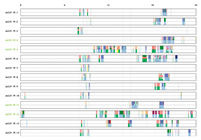 | 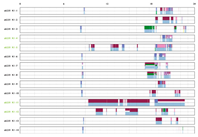 | 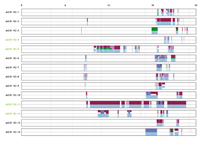 |
| c3.04 | 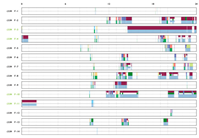 | 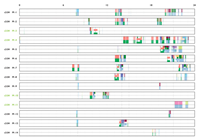 | 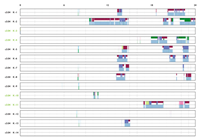 | - |
| a2.02 | 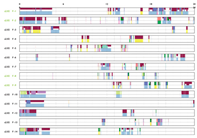 | 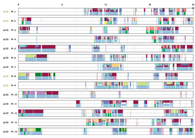 |  | 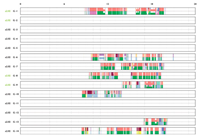 |
| c2.02 | 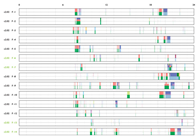 | 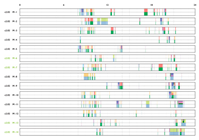 | 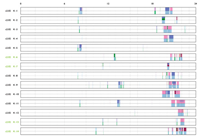 | - |
| b2.01 | 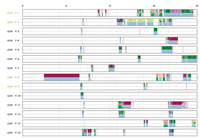 | 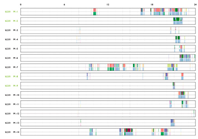 | 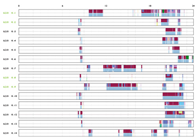 |  |
| c3.02 | 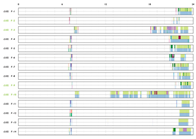 |  |  | - |
Disclaimer/Publisher’s Note: The statements, opinions and data contained in all publications are solely those of the individual author(s) and contributor(s) and not of MDPI and/or the editor(s). MDPI and/or the editor(s) disclaim responsibility for any injury to people or property resulting from any ideas, methods, instructions or products referred to in the content. |
© 2025 by the authors. Licensee MDPI, Basel, Switzerland. This article is an open access article distributed under the terms and conditions of the Creative Commons Attribution (CC BY) license (https://creativecommons.org/licenses/by/4.0/).
Share and Cite
Liu, F.; Wang, Y.; An, Q. Spatio-Temporal Analysis of Beijing Residents’ Lifestyles: Data-Driven Insights into Apartment Interior Design. Buildings 2025, 15, 576. https://doi.org/10.3390/buildings15040576
Liu F, Wang Y, An Q. Spatio-Temporal Analysis of Beijing Residents’ Lifestyles: Data-Driven Insights into Apartment Interior Design. Buildings. 2025; 15(4):576. https://doi.org/10.3390/buildings15040576
Chicago/Turabian StyleLiu, Feifei, Yuzhe Wang, and Qi An. 2025. "Spatio-Temporal Analysis of Beijing Residents’ Lifestyles: Data-Driven Insights into Apartment Interior Design" Buildings 15, no. 4: 576. https://doi.org/10.3390/buildings15040576
APA StyleLiu, F., Wang, Y., & An, Q. (2025). Spatio-Temporal Analysis of Beijing Residents’ Lifestyles: Data-Driven Insights into Apartment Interior Design. Buildings, 15(4), 576. https://doi.org/10.3390/buildings15040576





